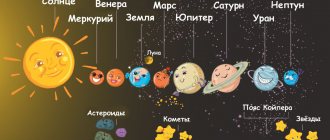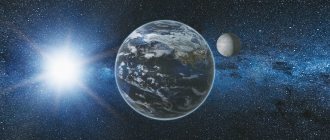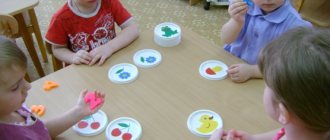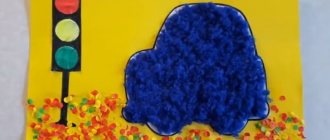Astronomy for children > Solar system
Description of the planets of the Solar System for children: consider the model of the Solar System and all the planets in order with photos and drawings, interesting facts about the Sun.
The solar system is a huge place with a lot of empty space between the planets. But there are also asteroids, comets, rocky and icy objects, and dwarf planets in the Kuiper Belt and Oort Cloud that have yet to be explored.
For the little ones , you need to know that the Solar System is represented by the Sun and the objects revolving around it: planets, asteroids, meteorites, comets and satellites. All of them extend from the main star (the ancient Romans called it "Sol") and pass the four inner planets through the Asteroid Belt to the four gas giants, the Kuiper Belt (disc-shaped) and beyond the giant Oort Cloud (spherical shape) and the teardrop heliopause . Researchers believe that the edge of the system is 15 billion km from the star.
This article will reveal the most interesting facts about the Solar System for children and provide a complete description of all planets and objects with photos, drawings, pictures and videos. In addition, you will find out which planet is the largest or smallest, the first and the last, hot and cold. Be sure to consider the diagram with the location and orbits, where all the planets of the Solar System are in full view.
Planets of the Solar System in order
By MAC definition, there are 8 known planets: Mercury, Venus, Earth, Mars, Jupiter, Saturn, Uranus and Neptune.
All planets are divided into two categories depending on their physical characteristics: terrestrial planets and gas giants.
Schematic representation of the location of the planets
Expanding the boundaries of the study of the Universe
The story about space and the Universe cannot be allowed to be boring. It is important to captivate the child. Arouse his interest in the subject. Only superficial knowledge may not satisfy the needs of a preschooler. We should tell you about Pluto, which was considered the 9th planet in the solar system. It was later removed from the list. The child will be interested to hear about asteroids, which are fragments of dead planets. Also interesting is the origin of comets that fly by with tails of gases. A separate topic should be a story about the Earth and its structure. The cosmic body consists of a core, mantle, and shell. You can compare it to the fruit of a tree, which has a seed and pulp. Everything should be presented in a playful way and then the child will find it interesting and exciting.
Terrestrial planets
Mercury
The smallest planet in the solar system has a radius of only 2440 km. The period of revolution around the Sun, equated to an earthly year for ease of understanding, is 88 days, while Mercury manages to rotate around its own axis only one and a half times. Thus, his day lasts approximately 59 Earth days. For a long time it was believed that this planet always turned the same side to the Sun, since periods of its visibility from Earth were repeated with a frequency approximately equal to four Mercury days. This misconception was dispelled with the advent of the ability to use radar research and conduct continuous observations using space stations. The orbit of Mercury is one of the most unstable; not only the speed of movement and its distance from the Sun change, but also the position itself. Anyone interested can observe this effect.
Mercury in color, image from the MESSENGER spacecraft
Its proximity to the Sun is the reason why Mercury is subject to the largest temperature changes among the planets in our system. The average daytime temperature is about 350 degrees Celsius, and the nighttime temperature is -170 °C. Sodium, oxygen, helium, potassium, hydrogen and argon were detected in the atmosphere. There is a theory that it was previously a satellite of Venus, but so far this remains unproven. It does not have its own satellites.
Venus
The second planet from the Sun, the atmosphere is almost entirely composed of carbon dioxide. It is often called the Morning Star and the Evening Star, because it is the first of the stars to become visible after sunset, just as before dawn it continues to be visible even when all the other stars have disappeared from view. The percentage of carbon dioxide in the atmosphere is 96%, there is relatively little nitrogen in it - almost 4%, and water vapor and oxygen are present in very small quantities.
Venus in the UV spectrum
Such an atmosphere creates a greenhouse effect; the temperature on the surface is even higher than that of Mercury and reaches 475 °C. Considered the slowest, a Venusian day lasts 243 Earth days, which is almost equal to a year on Venus - 225 Earth days. Many call it Earth's sister because of its mass and radius, the values of which are very close to those of Earth. The radius of Venus is 6052 km (0.85% of Earth's). Like Mercury, there are no satellites.
Earth
The third planet from the Sun and the only one in our system where there is liquid water on the surface, without which life on the planet could not have developed. At least life as we know it. The radius of the Earth is 6371 km and, unlike other celestial bodies in our system, more than 70% of its surface is covered with water. The rest of the space is occupied by continents. Another feature of the Earth is the tectonic plates hidden under the planet's mantle. At the same time, they are able to move, albeit at a very low speed, which over time causes changes in the landscape. The speed of the planet moving along it is 29-30 km/sec.
Our planet from space
One revolution around its axis takes almost 24 hours, and a complete passage through the orbit lasts 365 days, which is much longer in comparison with its closest neighboring planets. The Earth's day and year are also accepted as a standard, but this is done only for the convenience of perceiving time periods on other planets. The Earth has one natural satellite - the Moon.
Mars
Mars as seen by the Hubble Space Telescope in 2003
The fourth planet from the Sun, known for its thin atmosphere. Since 1960, Mars has been actively explored by scientists from several countries, including the USSR and the USA. Not all exploration programs have been successful, but water found at some sites suggests that primitive life exists on Mars, or existed in the past.
The brightness of this planet allows it to be seen from Earth without any instruments. Moreover, once every 15-17 years, during the Confrontation, it becomes the brightest object in the sky, eclipsing even Jupiter and Venus.
The radius is almost half that of Earth and is 3390 km, but the year is much longer - 687 days. He has 2 satellites - Phobos and Deimos .
Welcome to Earth!
We have already flown past Mercury and Venus, which means we will see Earth very soon. Our planet will be the third from the Sun. In size, the Earth is not the largest and not the smallest, but it is very different from others. With what? Our planet is the only place in the solar system where life exists. Thanks to its location from the Sun, water and clean air, living organisms began to appear on Earth many thousands of years ago. Only here you can see plants and animals, hear birds singing and visit many cities and countries where people live.
There is an interesting “neighbor” near our planet - the Moon. This is what we see in the sky every night. The Moon is a satellite of the Earth, which means that it revolves around our planet. The moon is so close to us that astronauts have even been there. Perhaps very soon scientists will begin to build special bases on the Moon where people can live.
Mercury
Sun-scorched Mercury is only slightly larger than Earth's satellite the Moon. Like the Moon, Mercury is practically devoid of an atmosphere and cannot smooth out the traces of impact from falling meteorites, so it, like the Moon, is covered with craters. The day side of Mercury gets very hot from the Sun, while on the night side the temperature drops hundreds of degrees below zero. There is ice in the craters of Mercury, which are located at the poles. Mercury completes one revolution around the Sun every 88 days.
Cold Uranus
Ahead is Uranus, the seventh planet of the solar system. Uranus is called the coldest planet, and there are also rings around it, but not as large as Saturn’s. Uranus is larger in size than Earth, but does not have a solid surface, so it can be called a gas planet. If you look at Uranus from space, it will be colored in an unusual blue-green color. This happens because there is a lot of methane gas on this planet, which gives the planet an incredibly beautiful hue.
Mars
Although details of the surface of Mars are difficult to see from Earth, observations through a telescope indicate that Mars has seasons and white spots at the poles. For decades, people believed that the bright and dark areas on Mars were patches of vegetation, that Mars might be a suitable place for life, and that water existed in the polar ice caps. When the Mariner 4 spacecraft arrived at Mars in 1965, many scientists were shocked to see photographs of the murky, cratered planet. Mars turned out to be a dead planet. More recent missions, however, have revealed that Mars holds many mysteries that remain to be solved.
Methods of representing space
Not every preschooler is able to understand what black holes are, what celestial bodies are made of, and what properties they have.
In order to explain, it is necessary to develop tactics. Firstly, the information must be truthful. Secondly, you cannot speak in serious language or use special terms. Otherwise, the child will quickly lose interest in the subject and will not want to continue a conversation he does not understand.
There are methods by which you can popularly teach children about the planets. Experience suggests that children are interested in conversation, supported by the display of pictures. You can use photographs of the starry sky, images of planets, constellations. It’s very good when dad draws the sun and talks about it. Moreover, the luminary should be depicted not as a yellow circle with rays emanating from it, but as a planet whose atmosphere contains hydrogen and helium.
A child must know the truth about the Universe. That people know little about the solar system and space. The sun is inaccessible due to high temperature, etc. In the same vein, we should talk about other planets and celestial bodies.
A model of celestial bodies can be depicted using plasticine. It's attractive and understandable. The main aspect is the child’s interest in the subject. His curiosity and desire to know more. In the case when the baby asks a question to which dad does not know the answer, it is necessary to postpone the consideration until tomorrow. And in the allotted time, prepare yourself for the correct answer.
Planets are giants
There are four gas giants located beyond the orbit of Mars: Jupiter, Saturn, Uranus, Neptune. They are located in the outer solar system. They are distinguished by their massiveness and gas composition.
Planets of the solar system, not to scale
Jupiter
The fifth planet from the Sun and the largest planet in our system. Its radius is 69912 km, it is 19 times larger than the Earth and only 10 times smaller than the Sun. The year on Jupiter is not the longest in the solar system, lasting 4333 Earth days (less than 12 years). His own day has a duration of about 10 Earth hours. The exact composition of the planet's surface has not yet been determined, but it is known that krypton, argon and xenon are present on Jupiter in much larger quantities than on the Sun.
Jupiter, image from Voyager 1 probe
There is an opinion that one of the four gas giants is actually a failed star. This theory is also supported by the largest number of satellites, of which Jupiter has many - as many as 67. To imagine their behavior in the planet’s orbit, you need a fairly accurate and clear model of the solar system. The largest of them are Callisto, Ganymede, Io and Europa. Moreover, Ganymede is the largest satellite of the planets in the entire solar system, its radius is 2634 km, which is 8% greater than the size of Mercury, the smallest planet in our system. Io has the distinction of being one of only three moons with an atmosphere.
Saturn
The second largest planet and the sixth in the solar system. In comparison with other planets, it is most similar to the Sun in the composition of chemical elements. The radius of the surface is 57,350 km, the year is 10,759 days (almost 30 Earth years). A day here lasts a little longer than on Jupiter - 10.5 Earth hours. In terms of the number of satellites, it is not much behind its neighbor - 62 versus 67. The largest satellite of Saturn is Titan, just like Io, which is distinguished by the presence of an atmosphere. Slightly smaller in size, but no less famous are Enceladus, Rhea, Dione, Tethys, Iapetus and Mimas. It is these satellites that are the objects for the most frequent observation, and therefore we can say that they are the most studied in comparison with the others.
Saturn, photographed by the Cassini spacecraft in 2007
For a long time, the rings on Saturn were considered a unique phenomenon unique to it. Only recently it was established that all gas giants have rings, but in others they are not so clearly visible. Their origin has not yet been established, although there are several hypotheses about how they appeared. In addition, it was recently discovered that Rhea, one of the satellites of the sixth planet, also has some kind of rings.
Uranus
The seventh and third largest planet, with a radius of 25,267 km. It is rightly considered the coldest planet among the rest, the temperature reaches -224 degrees Celsius. The length of a year is 30,685 days in earthly terms (almost 84 years), but a day is not much less than an earthly day - just over 17 hours. Due to the strong inclination of the planet's axis, sometimes it seems as if it does not rotate like the rest of the celestial bodies of our system, but rolls like a ball. This can be observed by anyone interested in astronomy; a geometric model of the solar system will clearly demonstrate this effect.
Uranus as seen by Voyager 2 in 1986
It has much fewer satellites than neighboring Saturn, only 27. The most famous are Titania, Ariel, Oberon, Umbriel and Miranda. They are not as large as satellites.
It is noteworthy that while observing Uranus through his telescope, astronomer William Herschel at first did not realize that he was observing the planet, being sure that he was seeing a comet.
Neptune
The size of the eighth planet in the solar system is very close to its nearest neighbor, Uranus. The radius of Neptune is 24547 km. A year on the planet is 60,190 days (approximately 164 Earth years). The strongest winds in our system have been recorded in the atmosphere, with speeds reaching 260 m/s.
Neptune as seen from Voyager 2
Compared to the other giant planets, it has very few satellites - only 14. The most famous of them are Triton, the third satellite in the solar system that has an atmosphere, Proteus and Nereid.
It is noteworthy that this is the only planet that was discovered not through observations, but through mathematical calculations.
Mysterious Saturn
Welcome to the sixth planet from the Sun called Saturn. Just like Jupiter, Saturn is made of gas, but it is much smaller in size than its neighbor. But Saturn has giant rings that make it easy to distinguish it from other planets. These rings are so huge that they can be seen even through a telescope. Scientists have been studying Saturn for many years, but until now they have not been able to understand how mysterious rings appeared around this planet. One thing is known: they all consist of particles of ice, dust, and stones.






